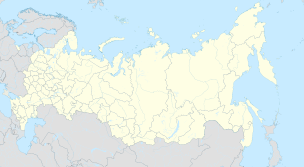SS Empire Byron
Empire Byron was a 6,645 GRT cargo ship which was built in 1941 for the Ministry of War Transport (MoWT). Completed in January 1942, she had a short service career. Empire Byron was torpedoed and sunk on 5 July 1942 by German submarine U-703 while a member of Convoy PQ 17.
Description
Empire Byron was built by
The ship was 416 feet 8 inches (127.00 m) long, with a beam of 56 feet 5 inches (17.20 m) and a depth of 34 feet (10.36 m). She was propelled by a
Career
Empire Byron was operated under the management of Haldin & Philipps Ltd.
- PQ 12
Convoy PQ 12 departed Reykjavík, Iceland on 1 March 1942.[4] It arrived at Murmansk on 12 March.[5] Empire Byron was a member of this convoy.[6]
- QP 9
Convoy QP 9 departed the Kola Inlet, Soviet Union on 21 March 1942 and arrived at Reykjavík on 3 April. Empire Byron was listed as a member of this convoy, with a destination of Immingham.[7]
- PQ 17
The ship's captain, John Wharton MBE,[9] and the 3rd Radio Officer, R Phillips, were each awarded a Lloyd's War Medal for Bravery at Sea for their actions in the sinking of Empire Byron. In the case of Phillips, the award was posthumous.[10] Those lost on Empire Byron are commemorated at the Tower Hill Memorial, London.[11]
Official Numbers and Code Letters
Official Numbers were a forerunner to
References
- ^ ISBN 1-85044-275-4.)
{{cite book}}: CS1 maint: multiple names: authors list (link - ^ "1169005". Miramar Ship Index. Retrieved 1 January 2010.
- ^ a b c "LLOYD'S REGISTER, STEAMERS & MOTORSHIPS" (PDF). Plimsoll Ship Data. Retrieved 1 January 2010.
- ^ "Tirpitz, the History". Bismark class. Archived from the original on 17 February 2009. Retrieved 1 January 2009.
- ^ "Battle of the Atlantic! March 1942". World War 2. Retrieved 1 January 2009.
- ^ "Arctic Convoys". Gordon Mumford. Archived from the original on 8 August 2009. Retrieved 1 January 2010.
- ^ "Convoy QP 9". Warsailors. Retrieved 1 January 2010.
- ^ "Convoy PQ 17". Mike Kemble. Archived from the original on 4 February 2010. Retrieved 1 January 2010.
{{cite web}}: CS1 maint: unfit URL (link) - ^ a b "Empire Byron". Uboat. Retrieved 1 January 2010.
- ^ "Lloyd's War Medal for Bravery at Sea (Part Two)". BBC. Retrieved 1 January 2010.
- ^ "Ship Index A-F". Brian Watson. Archived from the original on 6 October 2011. Retrieved 20 May 2011.

